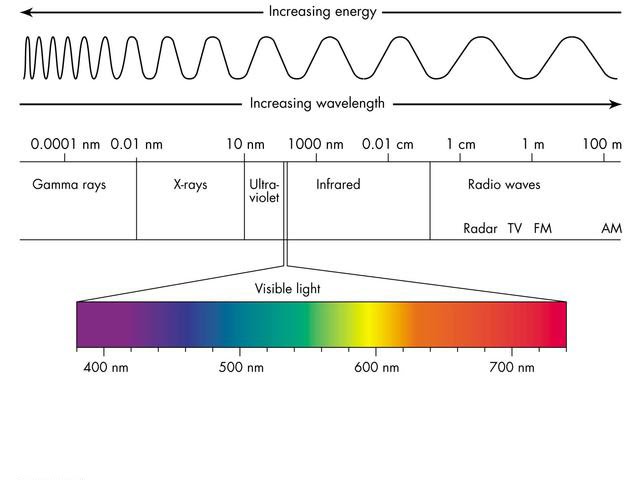Humans perceive colour through three kinds of cone cells that sense light (electromagnetic radiation) of different frequencies.
These cone cells have peaks of spectral sensitivity in short (S, 420nm - 440nm), middle (M, 530nm - 540nm), and long (L, 560nm - 580nm) wavelengths.
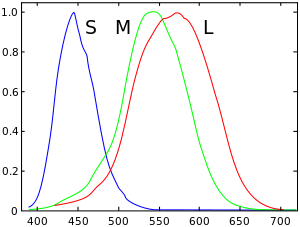
What we perceive as colour is a result of different light frequencies activating our three cone cells by different amounts. Hence, we can associate every distribution of light frequencies with a certain colour. This distribution of frequencies is known as a spectral power distribution (SPD). For example, the below diagram shows the SPD of daylight [2]. The combination of the relative amounts of these frequencies activating our cone cells produces the perceived colour of daylight.
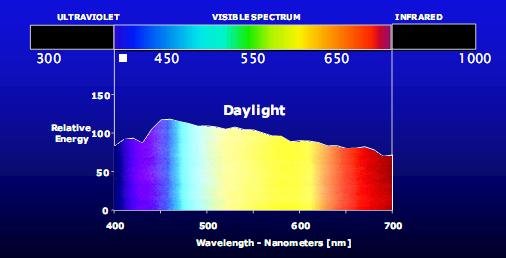
Given an SPD, we can convert it into sRGB, a widely used colour space for displays. This process is twofold. First, we convert the SPD into the XYZ colour space. Then the XYZ colour is normalized with respect to a whitepoint (in this example we use the D65 whitepoint), and converted to sRGB.
The XYZ colour space is described by three values $X,Y,Z$. The colour matching functions $\bar{x}(\lambda),\bar{y}(\lambda),\bar{z}(\lambda)$ describe the relative amounts that a given wavelength contributes to the values $X,Y,Z$ respectively.
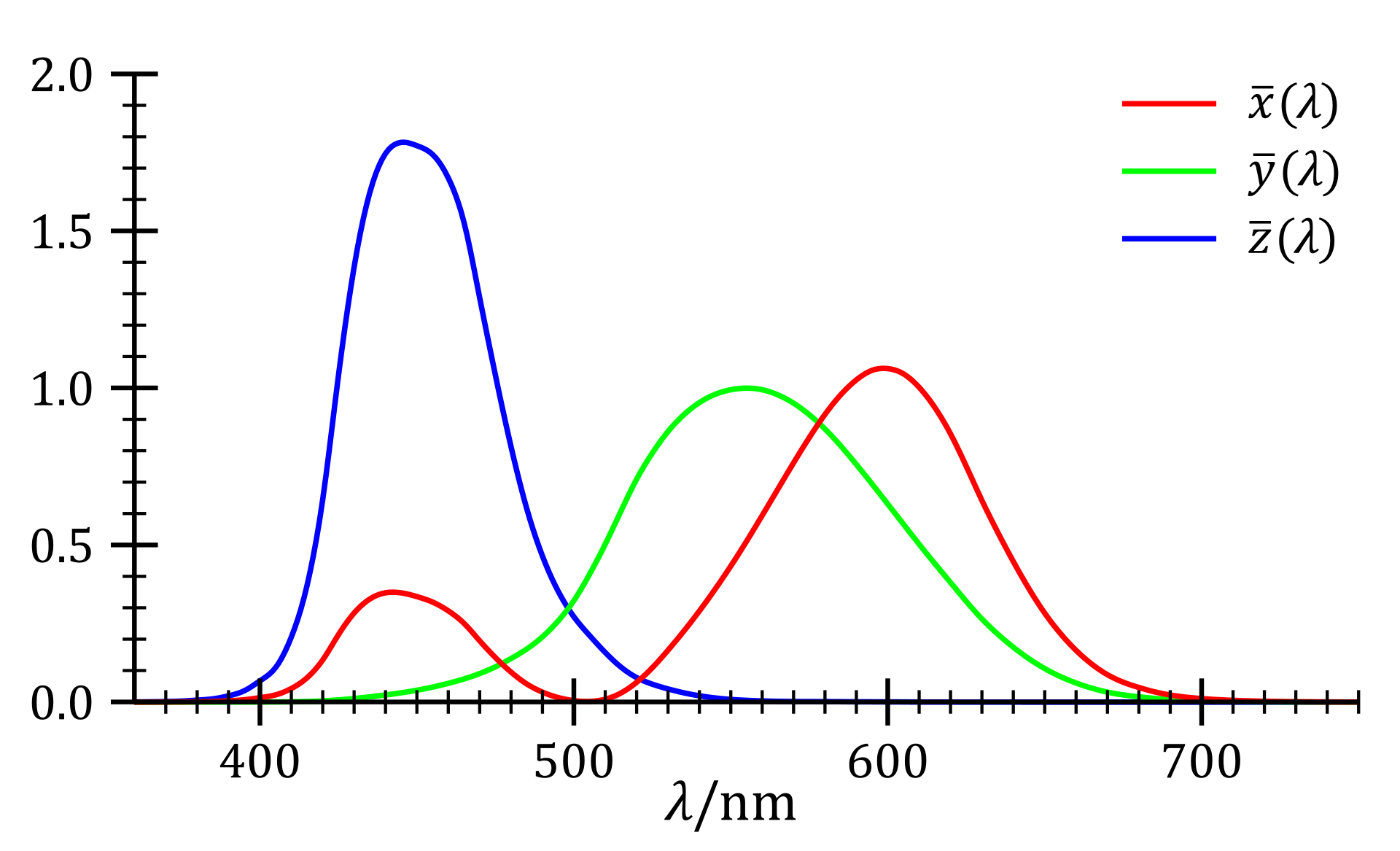
Hence, given an SPD $I(\lambda)$, we can find the $X$ value by multiplying $I(\lambda)$ with the colour matching function $\bar{x}(\lambda)$, then integrate the resulting function. Explicitly,
\[X=\int_{380}^{780}\bar{x}(\lambda)I(\lambda)d\lambda\]Similarly, for $Y$ and $Z$ we have:
\[\begin{align*} Y&=\int_{380}^{780}\bar{y}(\lambda)I(\lambda)d\lambda\\ Z&=\int_{380}^{780}\bar{z}(\lambda)I(\lambda)d\lambda \end{align*}\]In terms of implementation detail, we approximate the integration via a discrete sum. The colour matching functions $\bar{x}(\lambda),\bar{y}(\lambda),\bar{z}(\lambda)$ can be approximated using sums of piecewise Gaussian functions, given by [1].
We now normalize $X,Y,Z$ with respect to the D65 whitepoint. From the SPD $I_0(\lambda)$ of the D65 whitepoint, we can calculate its $X,Y,Z$ values, which we denote here by $X_0,Y_0,Z_0$.
The normalized values of $X,Y,Z$ with respect to the D65 whitepoint are then given by:
\[\begin{align*} X_{D65}&:=\frac{X}{Y_0}\\ Y_{D65}&:=\frac{Y}{Y_0}\\ Z_{D65}&:=\frac{Z}{Y_0} \end{align*}\]This process normalizes the $X,Y,Z$ values such that the normalized $Y$ value (which represents luminance) of the D65 whitepoint is 1.
Furthermore, the chromaticity values $(x,y)$ (see below) are unchanged.
Next, we convert the normalized XYZ values into sRGB:
\[\begin{bmatrix} R_{\text{linear}}\\G_{\text{linear}}\\B_{\text{linear}} \end{bmatrix}=\begin{bmatrix} 3.24096994 &-1.53738318 &-0.49861076\\ -0.96924364&1.8759675&0.04155506\\ 0.05563008&0.20397696&1.05697151 \end{bmatrix}\begin{bmatrix} X_{D65}\\Y_{D65}\\Z_{D65} \end{bmatrix}\]Finally, gamma correction must be applied to these values:
\[\begin{bmatrix} R\\G\\B \end{bmatrix}=\begin{bmatrix} \gamma(R_{\text{linear}})\\\gamma(G_{\text{linear}})\\\gamma(B_{\text{linear}}) \end{bmatrix}\]where
\[\gamma(u):=\begin{cases} 12.92u&u\leq 0.0031308\\ 1.055u^{1/2.4}-0.055&\text{otherwise} \end{cases}\]Converting XYZ to xyY
Additionally, we can also convert the XYZ colour value into the xyY colour space which is defined as:
\[\begin{align*} x:=\frac{X}{X+Y+Z}\\ y:=\frac{Y}{X+Y+Z} \end{align*}\]and $Y$ referring to the same quantity in both colour spaces.
The $(x,y)$ values denote chromaticity (see diagram below) and $Y$ is a measure of luminance (brightness).
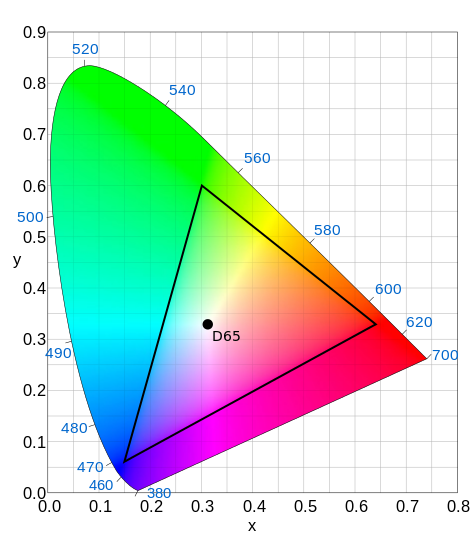
Interactive SPD to sRGB Converter
For best colour accuracy, you should view this on an sRGB monitor.
Superimpose a Gaussian distribution $f(\lambda)=a\cdot\exp\left(-\frac{(\lambda-\lambda_0)^2}{2\sigma^2}\right)$
Colour inaccuracy detected! The colour that would be produced by the given distribution requires an sRGB brightness greater than the permissible level (255).
Colour inaccuracy detected! The colour that would be produced by the given distribution of wavelengths falls outside of the sRGB gamut.
